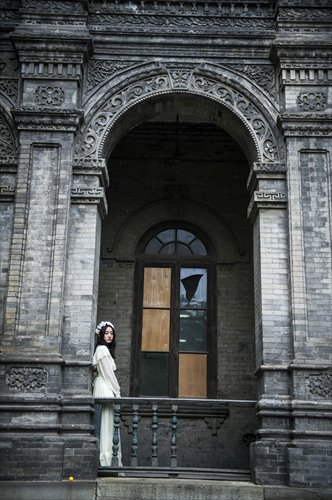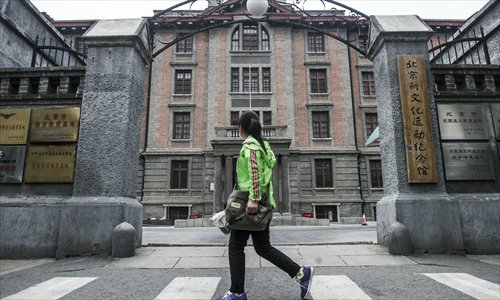

A young woman poses at the headquarters of the government led by Duan Qirui (1865-1936), who ruled China as premier from June 1916 to May 1917. The baroque-style building has been preserved, but the same cannot be said about many other local historic buildings razed amid modern urbanization. Photo: Li Hao/GT

The gate of Beida Honglou, the old campus of Peking University. Photo: Li Hao/GT
Architectural renaissance
Honking car horns, ringing bicycle bells, drilling from apartments under renovation and blaring loud speakers from retail stores. These are the typical sounds of the Xiangchang New Quarter in Xicheng district that, despite its dilapidated veneer, shows signs of the promise and optimism it once held nearly a century ago.
The Xiangchang New Quarter is home to some of Beijing's most classic examples of early modern architecture from the Republic of China (1912-49). The neighborhood also has the dubious honor of being Beijing's first failed attempt of Western-style urban planning.
In May, the Beijing Municipal Commission of Urban Planning held a seminar to discuss plans to renovate the Xiangchang New Quarter under the aim of restoring architecture to its former glory. The government is soliciting public opinions on the plan, but not everyone is a supporter. Some local residents are wary of past misguided urban renewal projects, while heritage activists claim it is a matter of too little, too late.
Notable buildings
In his 2004 book The Modern Architectural History of Beijing from the End of 19th Century to the 1930s, Zhang Fuhe, a professor of architecture at Tsinghua University, chronicled the history of the Xiangchang New Quarter.
In 1914, the government selected the area, situated near Longxugou, one of Beijing's poorest neighborhoods, to reconstruct it as a new commercial center. It was to become a model for future urban reconstruction projects in Beijing, but the project was abandoned following the outbreak of World War II and the central government's relocation to Nanjing, Jiangsu Province. The emergence of another business district along Chongwenmennei Dajie, near the Legation Quarter in Dongjiaomin Xiang, also caused the Xiangchang New Quarter to be neglected.
The area's key buildings included the Huakang Li brothel, New World Mall and Dongfang Hotel. The archway at Huakang Li still stands, but replacing the beautiful courtesans who once mingled with imperial scholars and bureaucrats are several local working-class families who reside there today. Rampant construction over past decades, much of it unapproved, has all but obliterated the building's original architecture.
The four-story New World Mall, designed by English architect L. Meyarva and built in 1917, resembled Shanghai's Great World Entertainment Center amusement hall, which opened in 1915, with its British-style dome top and Chinese-style verandas on each floor.
On June 11, 1919, Chen Duxiu, one of founders of Communist Party of China, stood on the New World Mall's fourth-floor balcony dropping leaflets of The Declaration of Peking Citizens, a manifesto he drafted demanding that all pro-Japanese ministers resign and that the government guarantee freedom of speech and assembly.
"The New World Mall was even more spectacular than the Great World Entertainment Center, but the whole building was demolished in the 1980s," said Li Yuxiang, cultural manager at the Dongfang Hotel.
The current site of the New World Mall is home to a high-rise residential compound. Ancient neighborhoods and hutong in Beijing have suffered a similar fate amid the capital's rapid urbanization, with widespread demolition and renovation projects reshaping the city's landscape.
Improving living standards
More than half of the residents at Taian Li, a two-story residential building built in the 1910s, have moved out over the past year. Most occupants today are employees of a construction company that rents the building.
A first-floor clothing store provides the only hint of the building's commercial roots. "These shoes are all of very good quality made by old Beijing factories," the store's owner, a middle-aged woman who asked to be anonymous, told Metropolitan as she sold a pair of black cloth shoes for 15 yuan ($2.40) to a customer.
The storeowner has lived with her husband and son in a two-room dwelling at the rear of the business for more than 20 years. The 20-square-meter front section is used for the store, while the rear has a bedroom for the family-of-three. The family inherited the store from the husband's mother after she died in 2013.
"A lot of our neighbors have moved to new homes to vacate the buildings for the government's project," the storeowner said, referring to the revitalization of the Xiangchang New Quarter. "They moved to Huilongguan [in Changping district] and another community far away in the city's west."
The storeowner and her family have also considered moving, but not until the conditions are right. "Of course we want to move, but we are still negotiating [with the government] on compensation. Life is inconvenient here. My son is 21 and ought to have his own room," she said.
Copyright ©1999-2018
Chinanews.com. All rights reserved.
Reproduction in whole or in part without permission is prohibited.